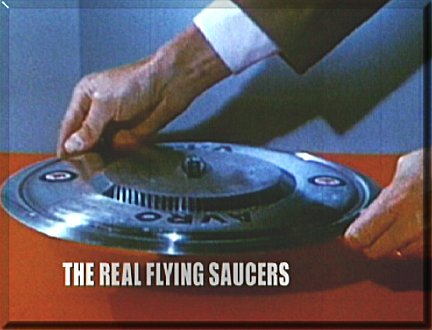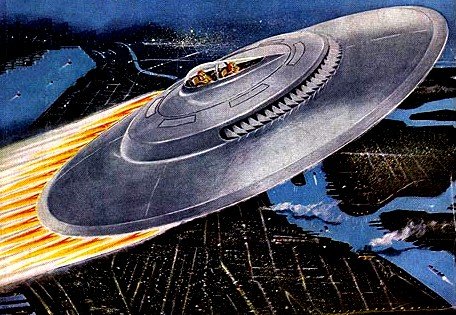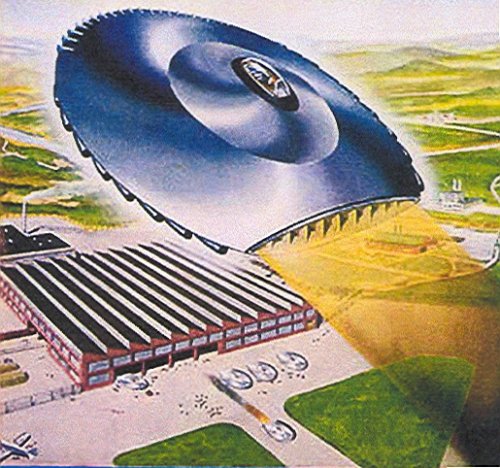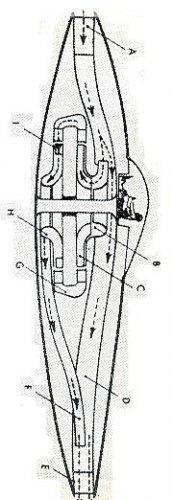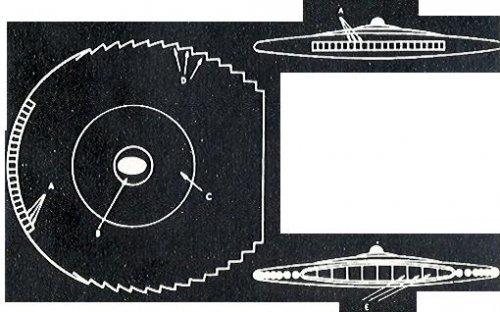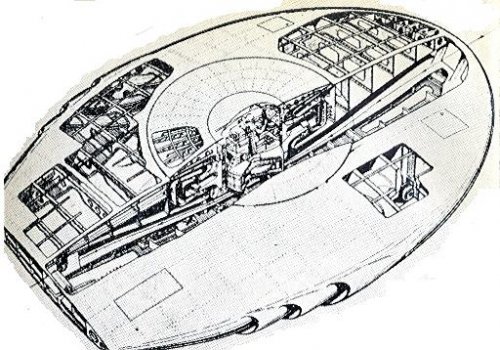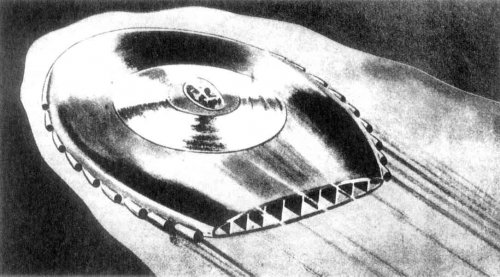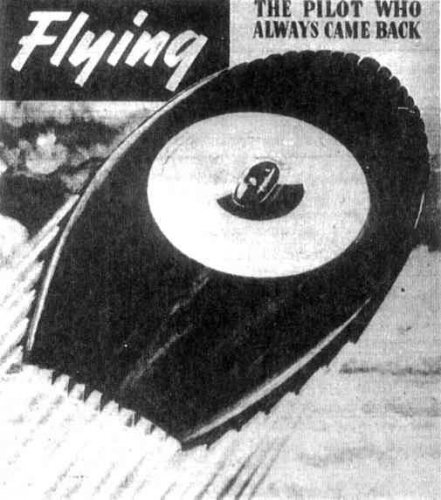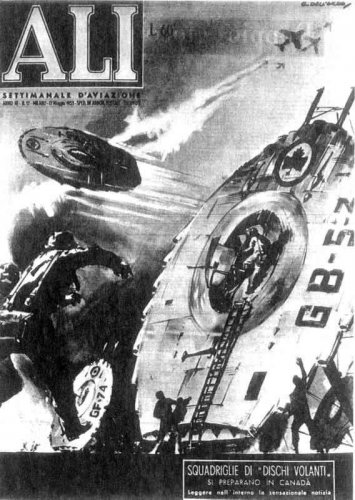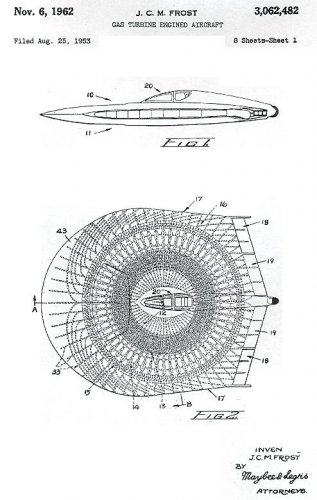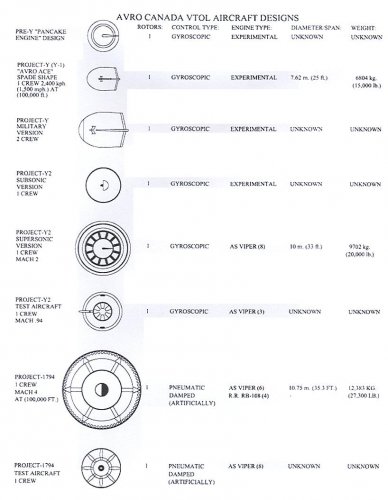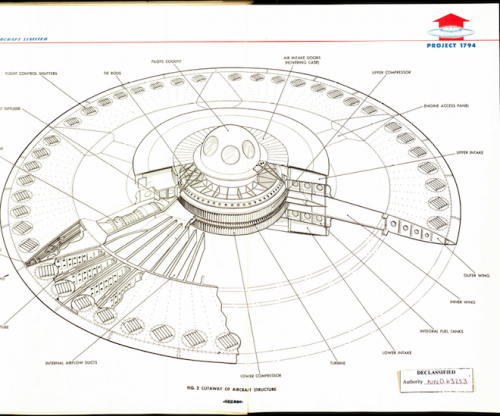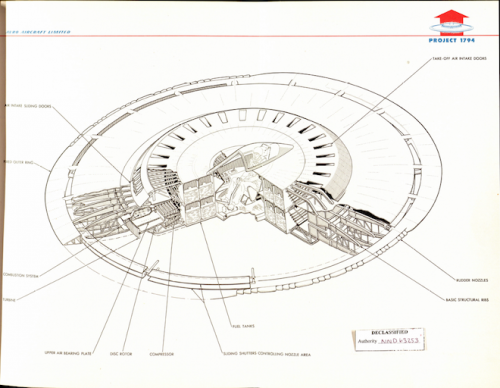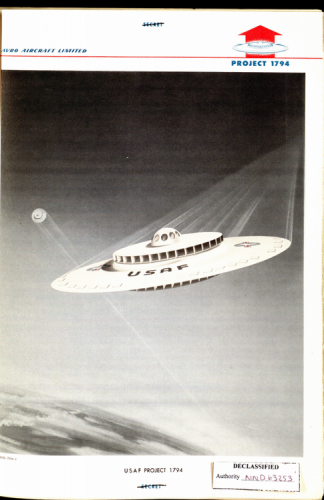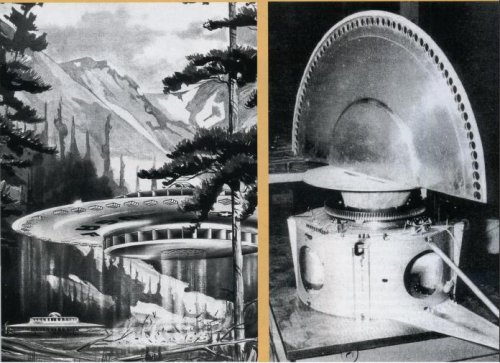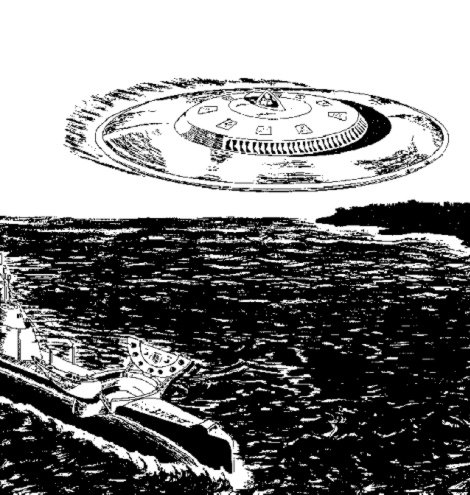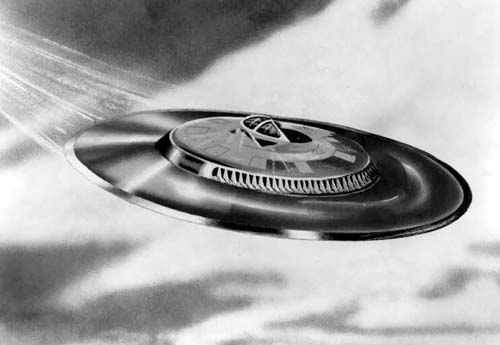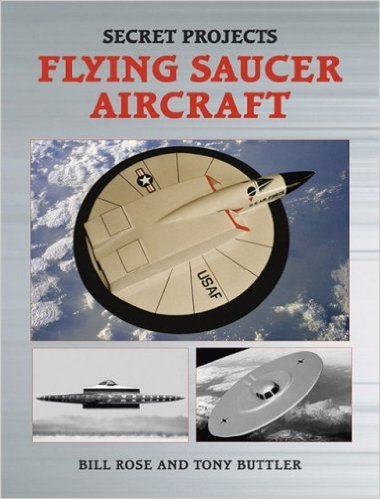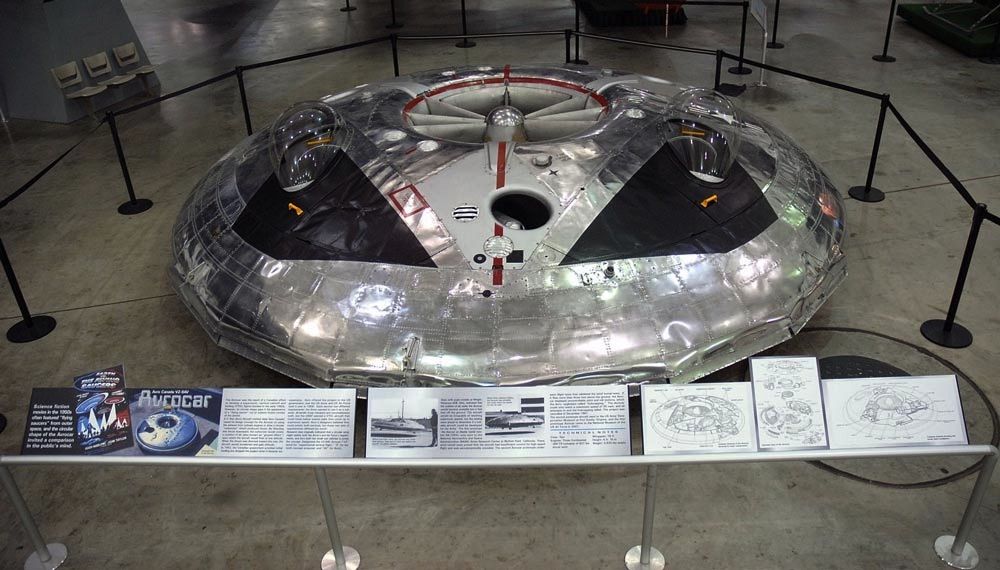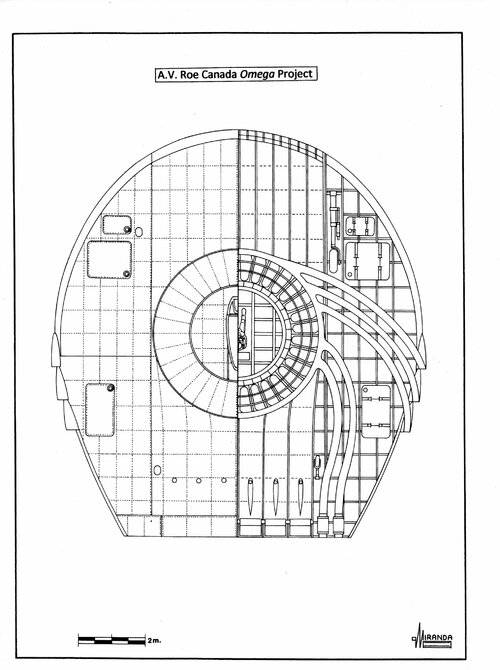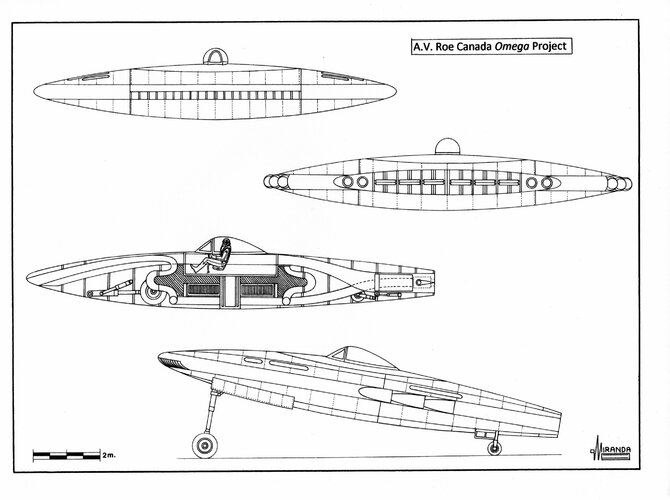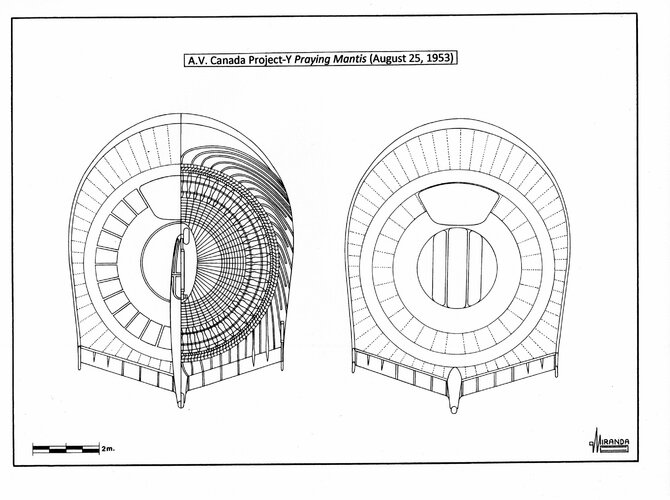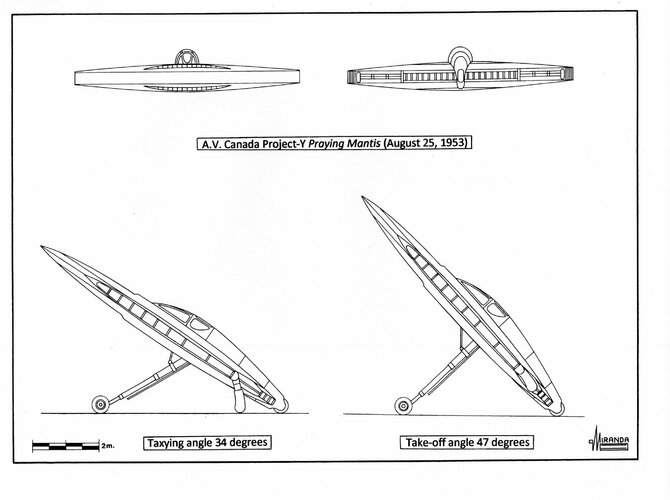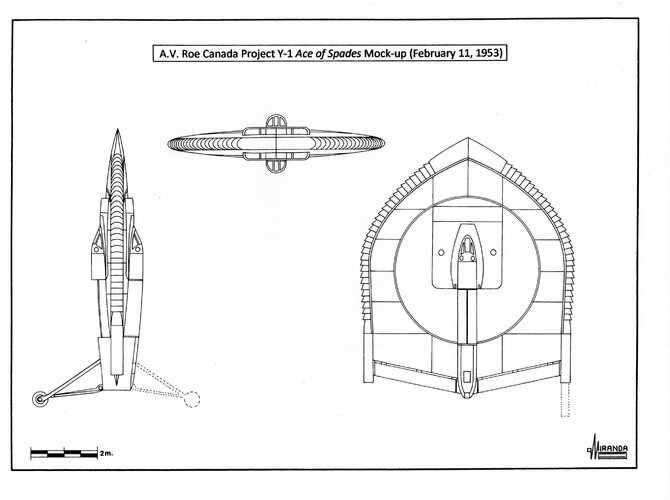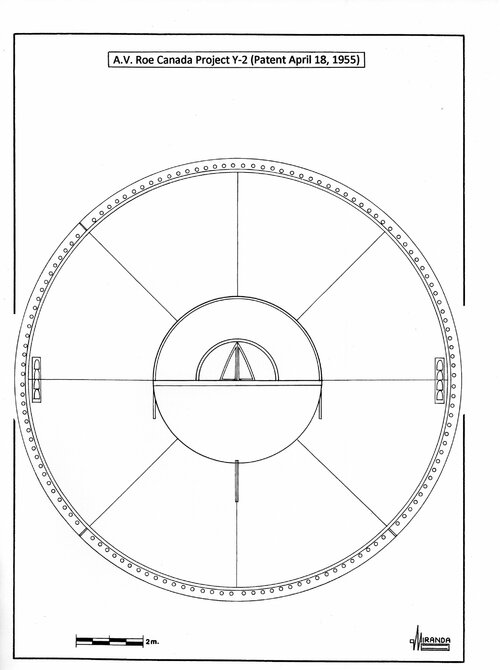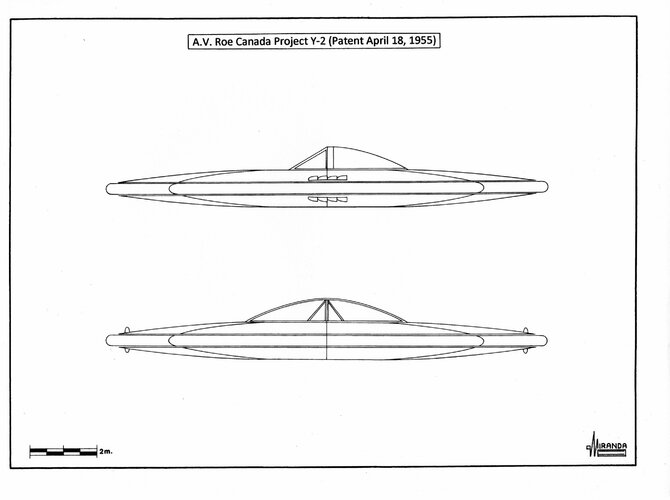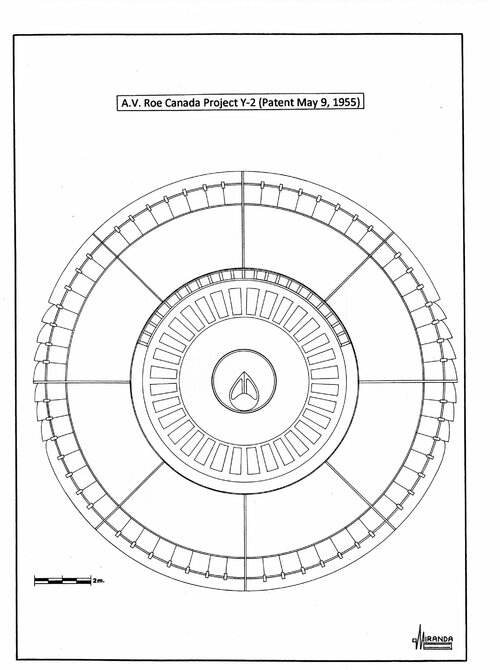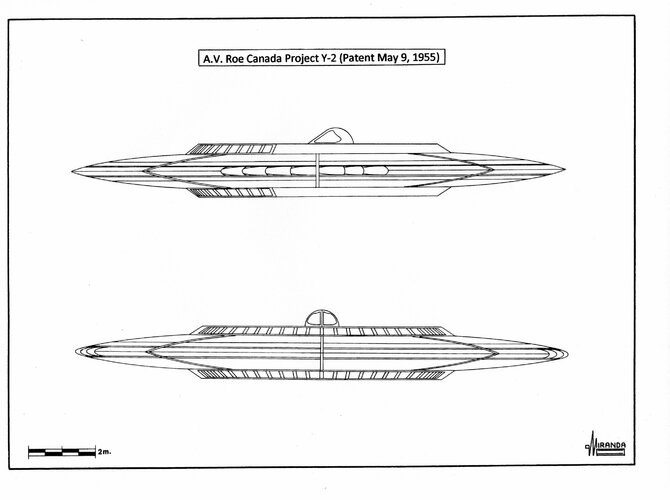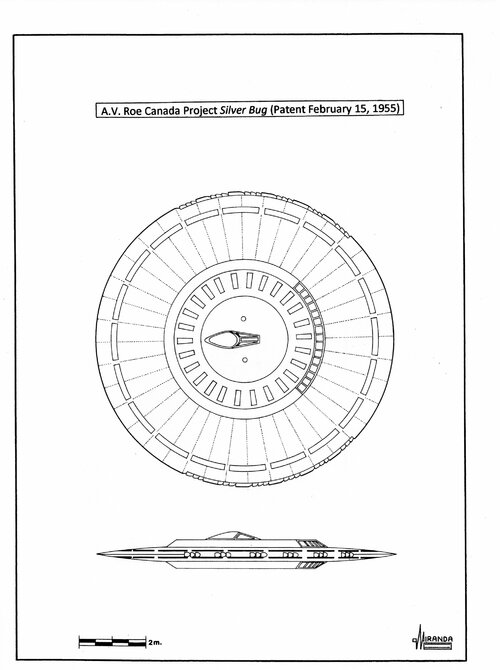In October 1945 John Frost, the project engineer of the D.H. 108, decided to use the German technology of the Messerschmitt Me 163 swept wing fighter with the cooperation of several German technicians. One of them was Dr. Waldemar Voigt, chef designer of Messerschmitt-Oberammergau AG.
Frost also had access to the information on tip jet-driven rotor helicopters, radial flow gas turbines and the Flügelrad propulsion concept that had been captured in Europe by the British Intelligence Objectives Sub-committee (B.I.O.S.). The development of the powerful BMW-Bramo radial-flow turbojet was continued at the British National Gas Turbine establishment.
In 1947 Frost joined A.V. Roe Canada Company, as project designer of the Avro XC-100 all-weather fighter, only ten days before Kenneth Arnold’s UFO encounter.
Fascinated by reports of UFO sightings, Frost concluded that the German technology could be used to build a flying disc. Privately and with a group of friends, he started the design of the tip jet-driven rotor Gyrodyne based in the Feuerball concept and a disc-shaped aircraft powered by an integral pancake radial-flow turbojet based in the Kugelblitz concept.
Researcher Tim Mattews states in the book 'UFO revelation' that in 1951 A.V. Roe employed several German scientists including the chief designer of the Kugelblitz project, Dr. Heinrich Richard Miethe.
Late in 1951 Frost made a proposal for a proof-of-concept saucer-like flying vehicle. Early in 1952 the A.V. Roe Special Projects Group was formed to investigate the Frost ideas.
On February 7, 1952, the Group distributed an internal document titled ‘Description and Thoughts on the Turbo Disc’ (a simple gas turbine halfway between a ram-jet engine and centrifugal engine), Frost also submitted the design to the engineering department of McGill University.
The radial-flow turbojet designed by the Frost team had twenty feet of diameter, 42,000 lbf minimum thrust at low pressure and an outstanding power-to-weight ratio of 1.73 to 1.
The horizontal Pelton-wheel turbine had a large multi-stage centrifugal compressor with the rotor blades mounted on the inner disc ring and the stator blades in the outer disc ring. The separate combustion system consisted of several combustion chambers with individual burners and nozzle guide vanes distributed in a radial pattern between the ribs of the vehicle.
This work led to the first design named Omega project, with elliptical planform, 36 ft wingspan, 40 ft overall length and 1 to 7 aspect ratio. It was proposed to control the vehicle by altering the direction of thrust forces.
The vehicle had twenty air-intake slots mounted in the nose, the new pancake engine was designed as an integral part of the airframe and the jet thrust exited from around the entire rim of the engine.
About three-fifths of the jet exhaust flow through a multiple jet-pipe assembly that direct the flow of gases in a rearward direction from the sides of the airframe for propulsion and the remainder is ejected from the trailing edge through ten deflector vanes comprising elevons and trimmers providing control in yaw, roll and pitch.
The idea of a supersonic aircraft with short take-off and landing (STOL) capabilities was proposed by the Special Project Group in April 1952, in the document titled ‘Proposal for a Gas Turbine Propelled Aircraft of Circular Planform’.
A second design (Project-Y July 1, 1952), was a modified variant of the Omega concept with ‘D’ shaped planform and deflector vanes replaced by two extra flaps.
The air for the engine is drawn in through two forward-facing intakes on the upper and lower surfaces of the fuselage.
The unusual landing gear consisted in a 13.7 ft long telescopic strut ended in a double tyre boggie, a tail wheel and two bumpers mounted in the tips of the fish tail. In the ground the airplane sat at a 47-degree angle on its tail, this arrangement led to the aircraft being called Praying Mantis.
Their scalloped nozzles on the airframe sides directed the jet thrust rearwards for near vertical 75-degree STOL operation, after a short run.
Two glass panels under the cockpit floor allowed the pilot to see the ground during landing.
Two wind tunnel models, including one afterburning version, were tested between December 1952 and January 1953 at the Hawker Siddeley-Woolford facilities.
Project-Y technical data
Wingspan: 22.3 ft (6.8 m), length: 29 ft (8.8 m), height: 21.2 ft (6.5 m), estimated max speed: Mach 2.25, estimated ceiling: 65,000 ft (19,817 m), estimated range: 1,000 miles (1,609 Km).
On July 1952, the Special Projects Group issued the report: ‘Project Y: An All-wing Supersonic Airplane’. This third design (August 21, 1952) named Project Y-1, was a tail-sitter supersonic interceptor with vertical take-off and landing capabilities.
The mock-up had been completed late in 1952 and revealed in April 1953.
For VTOL operation the landing gear strut was replaced by two landing legs that extended out of the dorsal and ventral spines. The exhaust flaps were replaced by large slots next to the tail and the side jet exhaust were covered by aerodynamic fairings to save drag.
Yaw control was obtained by means of additional jet-thrusters mounted to both sides of a new pointed nose.
These modifications produced a shape like a spade on a playing card and the Project Y-1 being called Ace of Spades.
The new project should compete against the el British Avro 724 VTOL all-weather interceptor and the lack of an airborne interception radar of the Y-1 was considered unacceptable. At that time, the AI radar required a second crew member, and the mock-up was modified with a second ventral cockpit for one radar operator lying in prone position.
The Ace of Spades was inherently unstable due the control problems added by the gyroscopic effect caused by the considerable mass inertia of their multi-chamber radial flow engine. The problem required an electronic stabilization control system, something not available with the current technology, and the project was cancelled in March 1954 in favor of a VTOL gyroplane with flat-riser configuration named Project Y-2.
Project Y-1 technical data
Wingspan: 21 ft (6.4 m), length: 25.6 ft (7.8 m), airframe thickness: 5.08 ft (1.55 m), wing surface: 380 sq. ft (116 sq. m), estimated top speed: 1,500 mph (2,400 kph), 2,287 mph (3,680 kph) with afterburner, estimated ceiling: 100,000 ft (30,500 m), estimated range: 780 miles (1,255 km), estimated rate of climb: 100,000 ft/minute, proposed armament: four 20 mm cannons, one retractable pack of Mighty Mouse air-to-air unguided rockets or two de Havilland Blue Jay (Firestreak) air-to-air missiles with IR guidance system.
In March 1953 Frost met with the wartime German engineer George Klein, who had taken part in the development of the Flügelrad Projekt. The reunion took place at a Canadian Government Facility in West Germany.
On August 23, 1953 Frost patented the Air Cushion Effect and in June 1954 published the report ‘Project Y-2: Flat Vertical Take-off Gyroplane’ a proof-of-concept vehicle named Project P.724.
The Y-2 was a true flying saucer design powered by one radial flow gas turbine which utilizes compressed air as its only means of lubrication.
Their VTOL capability was achieved by ducting engine exhaust to the periphery of the disc and deflecting the air flow downwards by means of the Coanda Effect. For transition to forward flight, the air flow would be gradually redistributed backwards by means of trim flaps.
The proposed Avro Y-2 Project P.724 (Patent April 18, 1955) had 44 ft. (13.4 m) of diameter and 5.9 ft. (1.8 m) of height. A new proposed version (Patent May 9, 1955) with 49 ft. (14.97 m) of diameter and 6.9 ft. (2 m) height, was powered by eight radially mounted Armstrong-Siddeley ASM Viper 5 axial-flow turbojets with 1,900 lbs. thrust each.
During the Cold War, the jet airplanes needed extremely long runways and there were few in existence that could be used by the USAF from their high-performance defense fighters.
Brig. Gen. Benjamin Kelsey, deputy director of research and development of the Air Force, called for a VTOL supersonic interceptor that would have been based in underground facilities.
But all the VTOL tail-sitters of that time: Convair XFY-1 Pogo, Lockheed XFV-1 Salmon, Ryan X-13 Vertijet, Northrop N-63, Martin Model 262 and SNECMA Coléoptère experienced serious stability problems during transition from horizontal flight to the vertical landing.
The tail-sitter formula was not successful as a practical vertical flight control system could not be found.
On August 13, 1954, the U.S. Air Research and Development Command issued Technical Requirement TR Nº 3 for a project development plan for the Avro Project P.724, under the codename Ladybird.
On September 16, 1954 U.S. Defense experts, led by USAF General D.L. Putt, visited the Avro Canada plant, and were briefed on Project Y-2, a flat-riser fighter design being funded by Avro, with some assistance from Canadian Defense Research Board.
On December 29, 1954, the USAF took over funding for the Project Y-2, on February 15, 1955 the technical document Project Nº 9961was prepared by the Air Technical Intelligence Centre (ATIC) at Wright-Patterson AFB. This report presents factual technical data on a scaled-down variant of the Project Ladybird with 29.2 ft of diameter, 70,000 ft ceiling and Mach 3.48 capabilities.
On January 17, 1955, the USAF re-designated it as Project Silver Bug, a supersonic interceptor powered by one improved Orenda radial flow gas turbine, with both upper and forward-facing air intakes for VTOL and forward flight configurations.
The Silver Bug proposal incorporates several advanced improvements. The aircraft was controlled by regulating shutters which vary the amount of thrust through annular nozzles for pitch and roll control and through the peripheral backward facing nozzles for yaw control.
Silver Bug technical data
Diameter: 29.2 ft. (8.9 m), height: 3.75 ft. (1.14 m), wing surface: 670 sq. ft, aspect ratio: 1.27, max weight: 29,000 lbs., thrust/weight ratio: 1.73, estimated max speed: 1,720 mph (2,300 kph) with afterburners, estimated ceiling: 80,600 ft, estimated time to 70,000 ft: 4.2 min, estimated range: 620 miles, proposed armament: four 20 mm cannons.

